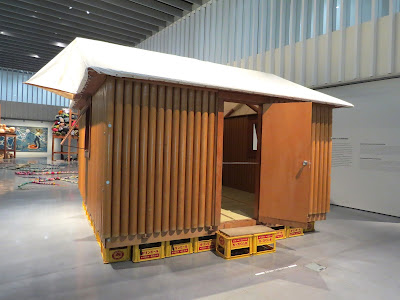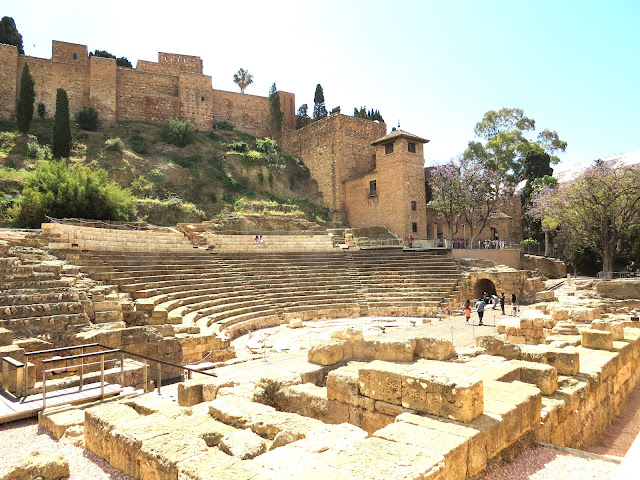Malaga, one of the oldest continuously inhabited cities in Europe, was founded by Phoenicians about 800 B.C.E. Since then it's been ruled by Carthage, Rome, Visigoths, a Muslim empire, a Catholic kingdom, a republic, a fascist dictatorship, and now a constitutional monarchy. This history is hinted at by the town's Arab fortification, the Alcazaba, and its Catholic cathedral. But what today's visitors see is a modern city of more than a half-million people with a singular emphasis on art and design.
The important art here isn't in centuries-old churches and the cathedral. Some seemingly random drawings by Pablo Picasso can be seen at the house where he was born in 1881, now the Museo Casa Natal Picasso, which is a good way to start taking in the art of Malaga. Signage and exhibits give some idea of Picasso's early years with his family. They left Malaga when he was 10. When he was 19, his father, an art instructor and artist himself, recognized that his son's talent was greater than his own and gave him his brushes and palette.
There are many more works by Picasso at the Museo Picasso Malaga, which draws bigger crowds than the birthplace museum. The Museo Picasso Malaga does not compare well with Picasso museums in Paris and Barcelona or even with Picasso collections in many modern art museums. It has a lot of works, but none of his best known, and much of what's here seem to repeat ideas that we've seen elsewhere. As always, though, one has to marvel at the sheer volume of his output.
Much more satisfying is the Centre Pompidou Malaga, a huge museum in a modern building on the harbor that opened in 2015 and exhibits a wide range of modern paintings, sculptures and installations. It seems as big and as significant as its mothership, the Centre Pompidou in Paris, something that can't be said for most "branch" museums.
If the Pompidou is a full meal of modern and contemporary art, the Centro de Arte Contemporaneo Malaga, or CAC, offers tapas. Small but delightful bites from contemporary artists. When we were there, a gallery was given over to the sculptures and paintings by the Baltimore-born and Brooklyn-based Theresa Chromati. One multi-painting installation, "Rehearsal for Joy," surrounded the viewer with color and energy.
Less captivating was the collection at the Museo Carmen Thyssen Malaga, which is housed in a 16th-century palace in an upscale shopping district. It's a much more traditional museum, with works from the 1500s to the 1900s with an emphasis on Spanish painters and depictions of Spain. It's beautifully curated but I found little of interest here.
Much more to my taste is the Museo del Automovil y la Mode de Malaga, a unique automobile and fashion museum in which some of the 100 or so cars have been outrageously customized and most are displayed with mannequins dressed for the car's time period. There are outfits by Dior, Gucci, Chanel, Galliano and other haut couture names. The museum is housed in part of what a century ago was a gigantic tobacco factory.
The art museums we visited, and we didn't see all the museums in town, were within a 15- or 20-minute walk of our hotel the Icon Malabar, where we checked in on Saturday, April 17, for four nights. The hotel is in a pedestrian district called the Artists' Barrio, a triangle with the working waterfront on one side, the Guadalmedina River on another and a tree-lined boulevard on the third. CAC is on the river at the edge of the barrio. To the east, the triangle points to a tree-lined promenade along the harbor and at the end of it is the Pompidou. The Picasso museums and the Carmen Thyssen are north of the Artists' Barrio in the narrow streets of the old quarter. We walked west along the water and through downtown for almost an hour to get to the auto museum, though we could have easily taken a city bus.
The auto museum is near the Misericordia beach, and the Pompidou is near the Malagueta beach. Even if we didn't come to this Costa del Sol town for its beaches, plenty of people do. In April we saw few people in the water but there were hordes of sunbathers.
Malaga may have a restaurant scene that we simply didn't find, but we didn't starve and found some OK places, one of which, La Deriva on the edge of the Artists' Barrio, we went to twice, mainly because it was close to our hotel but also because it was good. Another place we stopped in twice was the bar at the Only You Malaga hotel, where decent bartending made up for noisy tourists at other tables. The Only You is at the edge of the barrio on our walking route between the Icon Malabar and the old quarter, where there are a number of decent-looking restaurants with sidewalk tables near the cathedral. We had a good lunch at one of them, Lo Gueno de Strachan. And we found excellent pizza at Bresca in the barrio.
Here are some photos from Malaga:
 |
| A photo of Picasso displayed in the building where he was born. |
 |
| Ceramics created by Picasso in the early 1950s. Note the bullfight scene in the piece on the right. |
 |
| The queue to enter the Picasso Museum. |
 |
| I had expected to see family works such as this at the birthplace museum, but Picasso's portrait of his sister Lola, done in 1896 when he was 15, is at the Picasso museum. |
 |
| "Child with a Shovel." By 1971, this is how Picasso depicted children. |
 |
| Theresa Chromati titled this work "Steadfast, Step Into Me (Allow Silence to Create the Sounds You Desire Most." It was part of her one-woman show at the contemporary art museum CAC. |
 |
| "The Beau at the Soiree" by Eduardo Leon Garrido typifies the type of art shown at Carmen Thyssen. |
 |
| "La Puerto del Sol, Madrid," a 1902 work by Enrique Martinez Cubells, at the Carmen Thyssen. |
 |
| A gigantic multicolored cube announces the presence of the Centre Pompidou Malaga. |
 |
| The entrance to the Pompidou is on a sunken plaza. |
 |
| Stairs connect the entrance hall to the many galleries below. |
 |
| "The Arrival of Spring in Woodgate, East Yorkshire in 2011" by David Hockney is one of the largest paintings at the Centre Pompidou. |
 |
| "Paper Log House," 1995, by Shigeru Ban at the Centre Pompidou. |
 |
| Playa Malagueta is a short walk from the Centre Pompidou. |
 |
| A waiter speaks with potential customers at Lo Gueno, one of many sidewalk eateries near the cathedral. We had lunch here, but Casa Lola across the street looked good, too. |
 |
| The cathedral in Malaga is in the old quarter near the Picasso museum. |
 |
| The cathedral's main altar. |
 |
| This highly customized 1937 Lincoln is one of the first things you see at the automobile and fashion museum. |
 |
| A 1916 Buick headed for a fancy picnic. |
 |
| This 1923 Hispano-Suiza reminded me of Gloria Swanson's leopard-upholstered car in "Sunset Boulevard." |
 |
| BMWs today don't look quite as cool as this 1939 model. |
 |
| Bicycle storage in Malaga's old quarter. |



No comments:
Post a Comment